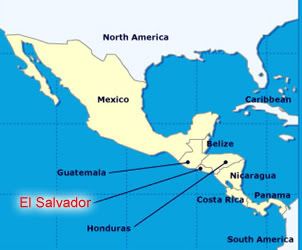The guest house in San Salvador was fine. No hot water and only intermittent electricity didn’t affect us much because we were hardly ever there, being out and about in the VAN on our important business. When we came home in the evening, we cooled off in the courtyard and ate dinner together at a long table in the main room, talking health care and labor unions and micro-lending, matters few of us knew anything about before the trip. We discussed the continuing political power of the moneyed few and whether the FMLN would ever win a national election.
The FMLN, or Farabundo Marti National Liberation Front, was the umbrella group for the armed opposition during the war. After the peace accords in 1992 it was reconstituted as a political party. The people of our “partner” community—I’ll get around eventually to explaining why I put that word in quotation marks—were all FMLN members, now settled on land granted them by the government as former combatants, really terrible land on the Lempa River near the Pacific Coast, in the hottest part of the country, where the soil was salinized and polluted from cotton production. We, Margaret's little band, tended to see Salvadoran life through FMLN eyes.
The other thing you need to know about El Salvador, if you don't already, is that many Roman Catholic clergy died there before and during the war. Priests and nuns who supported the poor, which was just about everybody in El Salvador, were gunned down by the armed forces, police or paramilitary groups with no compunction or accountability, in the same way that 60,000 or so peasants were murdered between the late seventies and early nineties. One of the clergy who died was Padre Octavio Ortiz, shot in 1979 while leading a retreat for youth. Our partner community, La Canoa, had renamed itself Comunidad Octavio Ortiz.
The other thing you need to know about El Salvador, if you don't already, is that many Roman Catholic clergy died there before and during the war. Priests and nuns who supported the poor, which was just about everybody in El Salvador, were gunned down by the armed forces, police or paramilitary groups with no compunction or accountability, in the same way that 60,000 or so peasants were murdered between the late seventies and early nineties. One of the clergy who died was Padre Octavio Ortiz, shot in 1979 while leading a retreat for youth. Our partner community, La Canoa, had renamed itself Comunidad Octavio Ortiz.
In this subtropical city, our VAN was black. Its seats, salvaged rather than original, were also black, and plastic. They sucked sweat from the backs of my thighs and kindly held it in pools, so I could sit in it. Here’s a picture out one of the van's windows, of the U.S. embassy, a bunker of a place. It's smaller than our embassy in Iraq, whose footprint is said to equal Vatican City’s, but I imagine that both compounds broadcast the same you’d-better-have-an-appointment message.
Margaret and Tom, our in-country guide, had set up meetings for us, lots and lots of meetings. In the next two days, courtesy of the van and van driver, we attended the church where Ortiz officiated, visited the community center where he died, toured a hospital, talked with hospital workers, and met with FMLN organizers, U.S. Ambassador Rose Likins, the director of USAID in El Salvador, textile union labor leaders, and a Jesuit who shared his analysis of the current situation. I hope this explains why I took so many notes.

